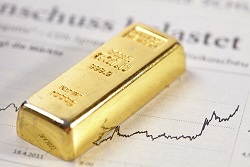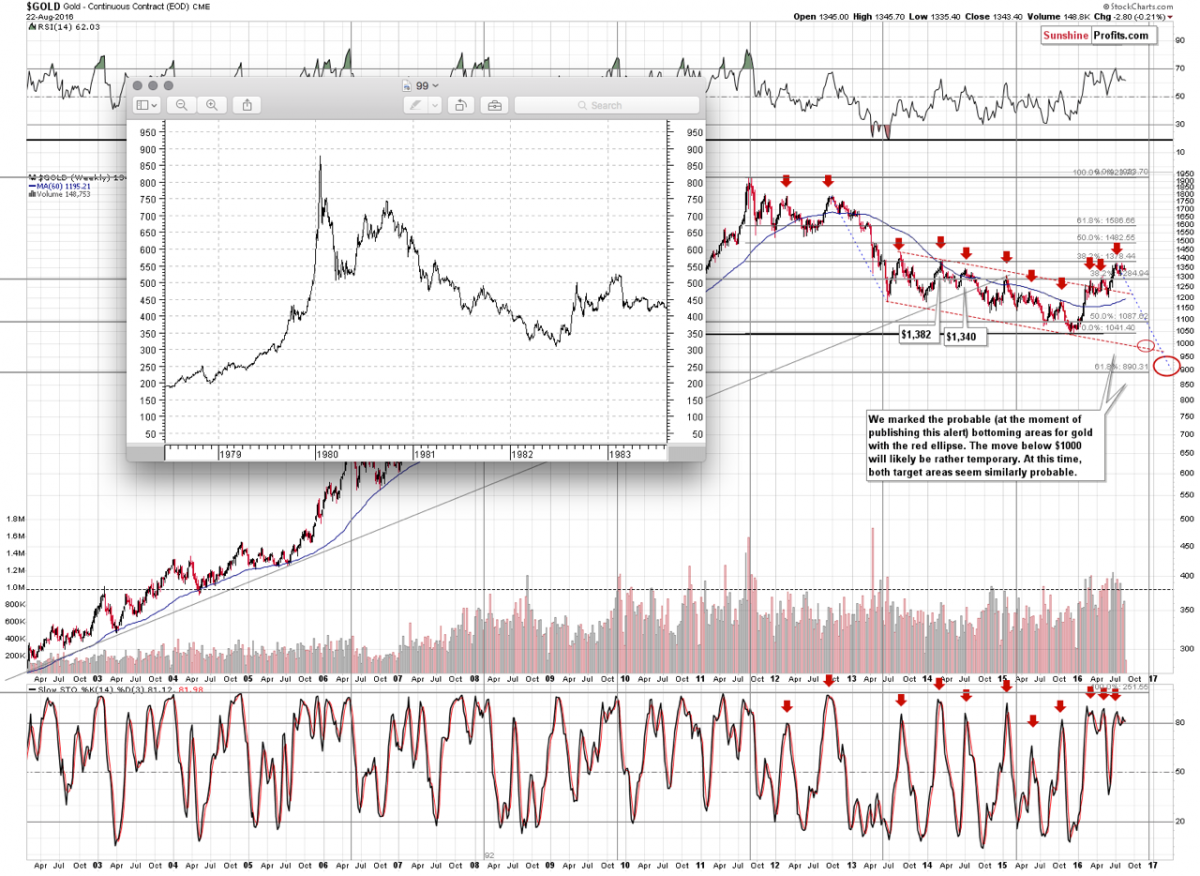Gold Price Prediction Based On The 1983 Analogy

Before we discuss the all-important similarity between the current gold price path and what we saw in 1983, we’d like to discuss why focusing on such similarities makes sense if it seems that gold’s price movement is simply based on the news – either from the Fed, the ECB, BoE or any other financial institution.
In the first week of August, two important pieces of financial news emerged. The more important one was the interest rate cut by the Bank of England and the less important was an employment report much better than expected. The more important of the above was bullish for gold (more easy credit – money) and the less important was bearish for gold (though indirectly as it doesn’t have to change the Fed’s approach). So why did gold decline over $13 in the week that they were both released?
Because there’s much more to what drives the price of gold than just simply pieces of information. If the price of the yellow metal was really driven by information, gold would move more or less randomly as news is sometimes good and sometimes bad and there’s a ton of it. Still, gold moved from $1,900 to below $1,100 despite the fundamental situation being positive and without an increase in the interest rates in the US. Later on, gold rallied despite an increase in the interest rates. Is the gold – news link really that simple? No, it is not.
Which brings us to another question – is knowing and analyzing fundamentals enough to enter and exit and enter the market at correct times (or more or less close to them)? Let’s reply to this question by reminding you of one situation in silver. What changed in the fundamental outlook for silver from July 2008 to October 2008? Did the world stop using silver? Did mine production suddenly increase? No. And yet silver’s price declined from $19.55 to $8.40 – it was more than cut in half. Something else was in the works. We won’t say that it was completely predictable right from the start of the slide to its very end, but it was completely unpredictable if one focused on fundamental information and news only. With technical, cyclical, fractal and other price-and-volume-based analyses one could have successfully exited the market at higher prices than the prices at which they would re-enter. By the way, we closed the long-term investment position in silver much higher than the current prices. However, we think we will have a much better opportunity to re-enter these positions than what we have today.
Ending the above digression – what could the early-August reaction tell us? That gold is ready to fall. Moreover, based on the 1983-today analogy (see below), it’s ready to fall hard. Why? Because gold failed to react to a bullish piece of news by rallying - and it (and the same goes for silver) reacted significantly (overreacted?) to the bearish piece of news. Several technical confirmations followed. Let’s take a closer look (charts courtesy of http://stockcharts.com and chartsrus.com).
If you’ve been following gold or in fact any other market for a long time, you have surely noticed that the price patterns tend to repeat themselves. At times gold does it to the letter, but in most cases, it is the shape of the move that matters most. This self-similarity pattern phenomenon can provide a roadmap of subsequent events – if we detect that we have such a pattern on our hands that is (Fractalyzer does that automatically, but some things can be also detected manually).
The more similar the patterns are the more likely it is that an analogous price action will follow.
Even at the first sight, both above charts are very similar. In any case, let’s take a closer look. There are multiple similarities in the pattern: the parabolic upswing, the two tops that followed it, the initial big decline after a breakdown below the initial low, followed by a less steep decline. In both cases after the “final” bottom, the initial rally was very sharp. Subsequently, we saw some sideways movement…followed by an additional rally a bit above the previous high.
The above makes the two cases very similar already. However, that’s not all there is to it. Both post-bottom rallies took a little more than six months before the decline resumed. How high did gold rally initially in both cases? More or less to the first visible local high.
The pattern is from the end of the previous bull market (1980 top) - and while we don’t think the bull market is completely over this time, the emotions that accompanied investors in 1980 are similar to those at the 2011 top. Consequently, there are good reasons to think that the price patterns after these tops can be similar.
What does the similarity mean? That the price pattern is likely to continue, so the follow-up action in the price pattern from the past can tell us a lot about what’s likely to follow.
What is likely to happen next? The same thing – or something very similar to it – that happened in the past after this pattern. In the past, gold rallied only a little above the previous high (the one that formed after the initial sharp rally) and then it topped and the top took the form of three smaller tops. After that, gold moved to new lows.
Gold moved above the initial high and it seems to have topped in the form of… three smaller tops: the first one was based on the Brexit vote, the second took place in early July - and the third one was seen in early August.
We already wrote that back then the rally was in place for a bit above six months and the same is the case right now. Consequently, the time may be up for the rally. To be clear, since the entire pattern is very similar but not identical, it could be the case that gold won’t decline for another month or so and it would not invalidate the pattern or make the subsequent decline less likely based on it. Overall, the time requirement for the top to be in is fulfilled.
What about the price? In the past gold moved more or less to the 38.2% Fibonacci retracement level based on the decline. Consequently, we can say the same about the recent upswing. Besides, the second and final top took form above the lowest of the previous local tops, but below the highest local top. That’s where gold topped recently as well. Moreover, even if gold rallies a bit more from here, it will still remain within the above pattern. So, what are the implications of the above? The clear implication is that gold is likely to decline (if not right away, then still rather soon) and the decline is quite likely to take gold to new lows.
Let’s keep in mind that back in 1983 gold moved a few dollars above the retracement before topping. Therefore, even a move to $1,400 or so would not invalidate the above. Still, such an upswing is not necessary or likely – after all, gold topped right at the retracement and there are many indications of extreme optimism among precious metals investors – strong indications that the top is in (or at hand).
Does the above imply that gold is likely to enter a prolonged period of low prices? No. Fundamentals remain positive for gold and they are likely to drive the yellow metal higher in the coming years, especially once enough investors hate gold and throw in the towel (in other words, when the optimism turns into excessive pessimism) and the huge rally can really begin.
Technically, the self-similar patterns’ implications become weaker and less reliable as we extend the time for which we are making a prediction. So, while the above analysis implies lower gold prices in the coming months and weeks, it doesn’t say anything about the coming years (or days, as the pattern is not of a short-term nature).
Speaking of the short-term – there is one thing that the similarity makes likely and that is that the next bigger pause will take place once gold moves to the previous important local lows (in case of past price moves, it was the late 1982 low that stopped the initial part of the decline) – which more or less corresponds to the $1,200 level at this time.
Naturally, there are multiple other factors (cycles, indicators, performance of other parts of the precious metals sector relative to gold, relative performance of gold vs. the USD Index and other currencies, the links between silver and non-US currencies, outlook for key ratios, volume levels in daily and weekly terms and many other factors) that need to be considered before taking a speculative position in the precious metals sector, or when considering whether using the core part of one’s gold portfolio (long-term investment capital) for gold and silver is really justified, but the analogy to the 1983 is a very important factor that should make current gold investors at least concerned about their holdings.
The above is up-to-date at the moment of posting this article and the situation can change in the following weeks. In order to stay updated on our latest thoughts on the precious metals market (including thoughts not available publicly), we invite you to sign up for our free gold mailing list. You’ll also get free 7-day access to our premium Gold & Silver Trading Alerts. Sign up today.
***************
Free Gold-Eagle Newsletter!
- Fresh weekly insights on gold, precious metals, and the economy
- Leading authors from around the world
- Always free
- Stay informed!


















